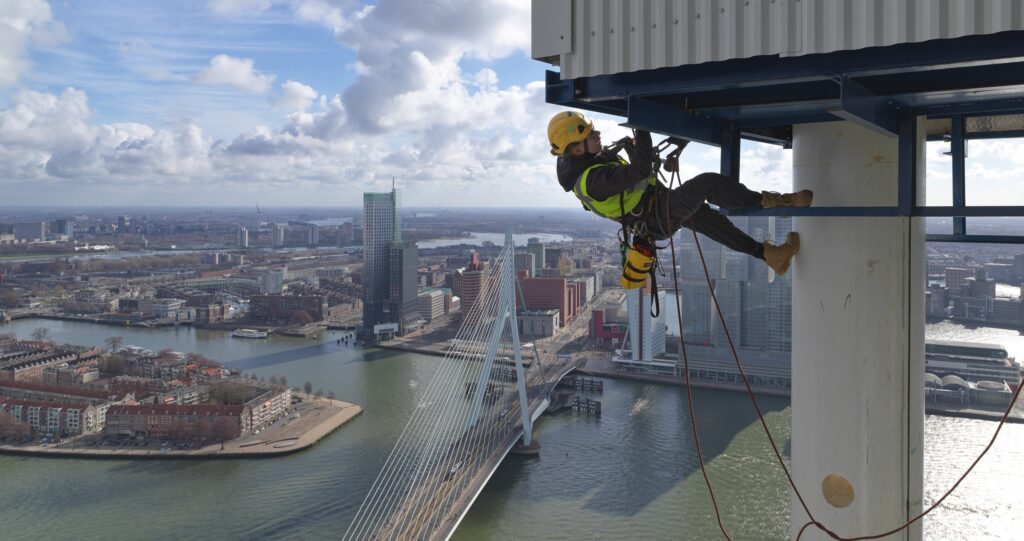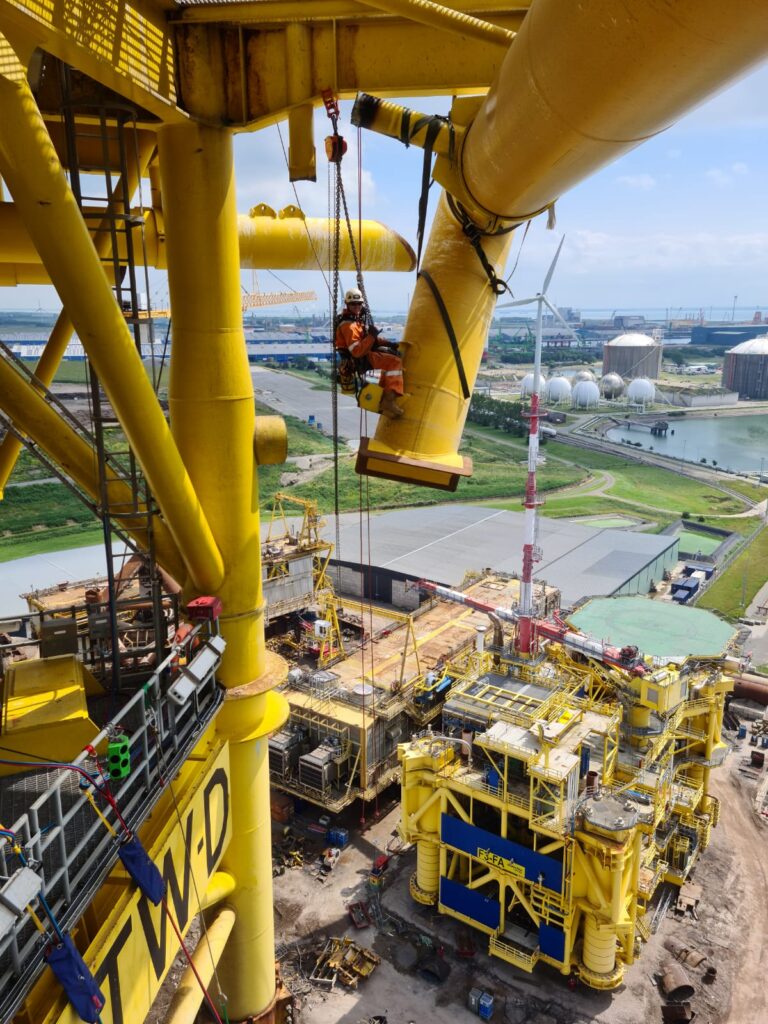Industrial rope access Working safely at height
What is rope access?
With rope access we use ropes, climbing techniques and safety equipment to gain access to inaccessible areas. This can be at height or in depth, such as work sites above water, in confined spaces or within buildings. Working with rope access allows us to avoid obstacles in a safe and efficient way in order to carry out work at height.
Rope access is used when other working methods are not safe, not possible or have a negative impact on the environment. Think, for example, of sloping roofs that you cannot reach with aerial work platforms or of work sites above water that you cannot reach with scaffolding.

Industrial climbing
Cowboys, alpinists, abseilers, industrial climbers. All terms to express rope access. A large number of people and companies in the Netherlands have seen us working, but are not yet familiar with the term ‘rope access’. Rope access is actually an expensive word for industrial climbing. Because, to put it bluntly, that is actually what we do: we climb to reach difficult locations and carry out various work activities.
The Dutch rope access market has grown strongly in recent years. More and more clients are using rope access to reach heights, whereas in the past they saw it as something dangerous. But once our clients have experienced this working method, they abandon their prejudices. Industrial climbing is safe, efficient and flexible. At the same time, it increases safety by significantly reducing the number of hours at risk.
How safe is rope access?
The working method is safe if the IRATA guidelines are followed. IRATA stands for Industrial Rope Access Trade Association and is an organisation that focuses on the safe execution of rope access. Every IRATA member must adhere to certain guidelines and rules that IRATA controls.
Where do you use rope access?
Rope access can be used anywhere to reach an inaccessible place.
Take for example the civil & infrastructure sector. Where in the past all buildings were rectangular and easy to reach, nowadays this is different. The cities are full of the most beautiful buildings that look more like a work of art. This makes the challenge for maintenance and assembly a lot bigger. Most scaffolding and aerial work platforms cannot (safely) reach these places, making rope access the best solution.
The civil & infrastructure sector is not the only one where rope access can be used. Bilfinger Height Specialists is active in five branches, for example, in the marine & offshore and process & petrochemical industry. Think for example of boat platforms, port cranes, on board of ships but also of industrial estates, refineries and tank farms.

What are the advantages of using rope access?
- Rope access can make any place accessible.
In height or depth, there is always a solution to reach an ‘inaccessible’ place. - It is a safe way to work at height.
When carried out according to the IRATA guidelines, is a safe way of working at height. Technicians are attached to two independent anchor points, so there is always a backup line present. Read about all the reasons why IRATA is an even more safe way of working at height. - It is fast & efficient.
Rope access is quickly built up and broken down. This makes it time-saving and also suitable for urgent assignments. - It brings minimal inconvenience.
Rope access takes up very little space compared to other working methods, which means that the inconvenience for the ongoing business processes is kept to a minimum. - It is an environmentally friendly working method.
Where other working methods emit a lot of gases, the rope techniques are used to reach the work site. This makes it an environmentally friendly working method.

What kind of work can you do using rope access?
The workplaces where we can use rope access are infinite, and so are the activities. The most common activities in the civil sector are window cleaning, maintenance and support in the construction industry. However, in the offshore sector the most common activities are non-destructive testing, decommissioning, coating and stand-by rescue teams.
What is a rope access technician?
A rope access technician is someone who has experience with rope techniques by participating in training courses and by execution in practice. An IRATA certified rope access technician is someone who is trained to work safely at height with rope access.

How can i sign up for a rope access training?
We give monthly IRATA level 1, 2 and 3 training courses in our training centre in Bergschenhoek. Check out our IRATA training schedule, select your date and sign up!
How can we help you?
Contact information
